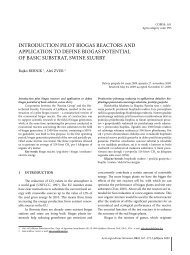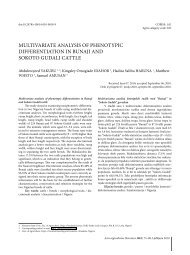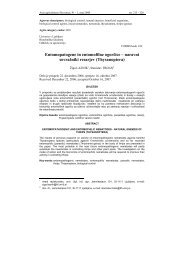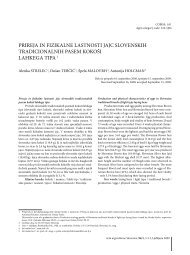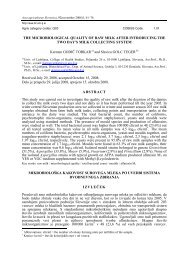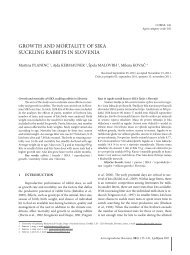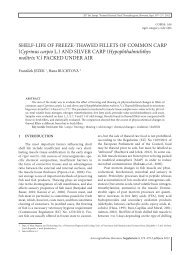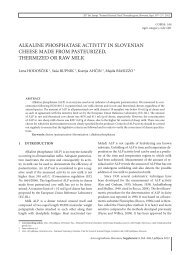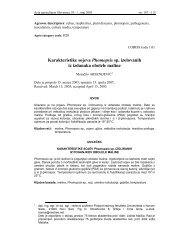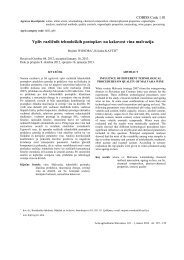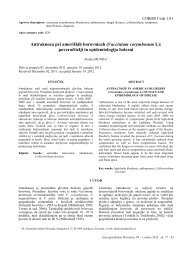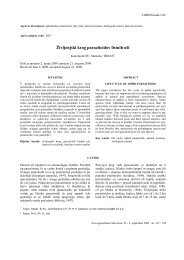GENETIC CHARACTERIZATION OF ALPINE SHEEP BREEDS ...
GENETIC CHARACTERIZATION OF ALPINE SHEEP BREEDS ...
GENETIC CHARACTERIZATION OF ALPINE SHEEP BREEDS ...
Create successful ePaper yourself
Turn your PDF publications into a flip-book with our unique Google optimized e-Paper software.
Acta agriculturae Slovenica, suplement 2 (september 2008), 79–84.<br />
http://aas.bf.uni-lj.si<br />
Agris category codes: L10 COBISS Code 1.08<br />
<strong>GENETIC</strong> <strong>CHARACTERIZATION</strong> <strong>OF</strong> <strong>ALPINE</strong> <strong>SHEEP</strong> <strong>BREEDS</strong><br />
Chiara DALVIT a) , Elena SACCA b) , Martino CASSANDRO a) , Martina GERVASO a) , Emilio<br />
PASTORE a) and Edi PIASENTIER b)<br />
a) University of Padova, Department of Animal Science, Viale dell’Università 16, 35020 Legnaro (PD), Italy<br />
b) University of Udine, Department of Animal Science, via S. Mauro 2, 33010 Pagnacco (UD), Italy<br />
ABSTRACT<br />
The aim of this study was to characterize from the genetic point of view eight alpine sheep<br />
breeds reared in Italy (Bergamasca, Biellese, Schwarzbraunes Bergschaf and Tiroler Bergschaf),<br />
Germany (Brillenschaf and Weisses Bergschaf) and Slovenia (Bovška and Jezerzko-Solčavska)<br />
through the use of microsatellite molecular markers. Allelic richness was rather high in each<br />
breed highlighting a considerable genetic diversity. However, the study evidenced a significant<br />
departure from Hardy-Weinberg equilibrium in all analyzed breeds caused by a heterozygote<br />
deficiency. Such lack seems to be caused by a rather high level of inbreeding. The genetic<br />
differentiation among breeds was rather low (FST = 0.064) but significant. The neighbour-joining<br />
tree obtained from Reynolds’ genetic distance estimates, showed the presence of three groups<br />
formed by the three Bergschaf breeds, the Italian Bergamasca and Biellese and the two<br />
Slovenian breeds together with the German Brillenschaf. Such grouping is in accordance with<br />
the breeds’ region of origin and with their known history. Concluding, microsatellite resulted to<br />
be a useful tool to investigate breed variability and to characterize alpine sheep breeds. Obtained<br />
findings suggest the need to set up a conservation plan aiming to safeguard and increase the<br />
genetic variability of the studied breeds compromised by the high level of inbreeding.<br />
Microsatellites genotyping could help to monitor breed variability and to organize matings.<br />
Key words: sheep / breeds / microsatellites / genetic characterization<br />
GENETSKA KARAKTERIZACIJA ALPSKIH PASEM OVC<br />
IZVLEČEK<br />
Namen študije je bil opisati osem pasem ovac, rejenih v Italiji (bergamaška, bieleška, črno-rjava<br />
gorska in tirolska gorska ovca), Nemčiji (brillenschaff in bela gorska ovca) in v Sloveniji<br />
(bovška in jezersko-solčavska) z mikrosatelitskimi markerji. Visoko raznovrstnost alelov smo<br />
našli v vseh pasmah, kar kaže na pomembno genetsko raznovrstnost. V študiji je evidentiran<br />
značilen odstop od Hardy-Weinbergovega ravnovesja v vseh analiziranih pasmah kot posledica<br />
heterozigotnega primanjkljaja. Le-ta naj bi bil posledica visoke stopnje parjenja v sorodstvu.<br />
Genetsko razlikovanje med pasmami je bilo dokaj nizko (FST = 0,064) vendar značilno. Sosedsko<br />
povezovalno drevo, povzeto po Reynoldsovi oceni genetske razdalje, je pokazalo prisotnost treh<br />
skupin iz treh pasem gorskih ovc, italijanske bergamaške in bieleške in dveh slovenskih pasem<br />
skupaj z nemško brillenscahaff. Takšno grupiranje je v skladu z rejskimi izvornimi področji<br />
posameznih pasem in njihovim znanim poreklom. Mikrosateliti so torej primerno orodje za<br />
preučevanje raznolikosti pasem in za opredelitev alpskih pasem ovc. Dobljeni rezultati kažejo,<br />
da je potrebno narediti ohranitveni načrt za zavarovanje in povečanje genetske raznolikosti<br />
preučevanih pasem, ki so že tako ogrožene zaradi visoke stopnje parjenja v sorodstvu.<br />
Genotipizacija mikrosatelitov lahko pripomore pri spremljanju raznolikosti pasem in<br />
organiziranju parjenja.<br />
Ključne besede: ovce / pasme / mikrosateliti / genetska karakterizacija<br />
16 th Int. Symp. “Animal Science Days”, Strunjan, Slovenia, Sept. 17–19, 2008.
80<br />
Acta agriculturae Slovenica, suplement 2 (september 2008).<br />
INTRODUCTION<br />
Alpinet Gheep – Alpine network for sheep and goat promotion for a sustainable territory<br />
development – is a project developed by fifteen partners from Italy, Austria, Germany and<br />
Slovenia within the European Union cooperation programme Interreg IIIB Alpine Space. The<br />
project realised a specific survey (Feldmann et al., 2005) on the consistency and diffusion of the<br />
main sheep and goat breeds in the Alpine area. The study revealed the presence of 60 different<br />
sheep breeds. A considerable number of them is under conservation programs while a not well<br />
defined number has already died out. Sheep and goat breeding in the Alpine area, has been<br />
decreasing continuously since about fifty years although it represents important economic,<br />
environmental and sociological issues. Sheep and goat production is frequently the only possible<br />
enterprise in marginal areas and play an important environmental role (Rancourt et al., 2006).<br />
Moreover, in these less favourite areas, many typical products, especially cheeses, have been<br />
developed from sheep and goat milk and, they are often linked to one autochthonous breed<br />
(Scintu and Piredda, 2007). Considering the importance of sheep breeding in marginal areas, and<br />
the general level of endangerment of local populations, this work aimed to genetically<br />
characterize some Alpine sheep breeds located in three European countries (Italy, Germany and<br />
Slovenia). The study was carried out investigating nineteen microsatellite molecular markers.<br />
Microsatellites are particularly suitable for this kind of studies and have already been used in<br />
many different species (Jordana et al., 2001; Dalvit et al., 2008; Glowatzki-Mullis et al., 2008).<br />
A deeper knowledge of the genetic variability and diversity of the analyzed populations will help<br />
to estimate their possible degree of endangerment and to suggest possible solutions for their<br />
conservation.<br />
Animal sampling and microsatellite analysis<br />
MATERIAL AND METHODS<br />
A total of 306 individual blood samples were collected from the following populations:<br />
Biellese (BIE, 44), Bergamasca (BER, 45), Schwarzbraunes Bergschaf (SBE, 41), Tiroler<br />
Bergschaf (TBE, 30), Bovška (BOV, 40), Jezerzko-Solčavska (JSO, 49), Brillenschaf (BRI, 28)<br />
and Weisses Bergschaf (WBE, 29). Analyzed animals can be considered as a representative<br />
sample of the breed of origin as they were collected from different flocks trying to avoid closely<br />
related individuals; the number of sampled farms varied from 4 to 17. Blood samples were<br />
collected from each animal in 5 ml vacutainer tubes containing sodium citrate as anticoagulant,<br />
and stored at – 20 °C until analyses were performed. DNA extraction was carried out employing<br />
the “Gentra System PUREGENE DNA purification kit” (Gentra System, Minneapolis,<br />
Minnesota, USA) starting from 300 µl of whole blood. DNA samples were then amplified by<br />
PCR in correspondence of the following 19 loci: OarAE54; OarFCB20, URB58, McM527,<br />
INRA23, TGLA53, MAF65, OarCP49, MAF214, HSC, INRA63, McM42, OarAE119,<br />
OarAE129, ILSTS087, OarFCB304, OarCP34, OarCP20 and CSRD247. The investigated loci<br />
were chosen, according to ISAG/FAO Standing Committee Recommendations (2004), and<br />
consulting a previous study on Austrian sheep breeds (Baumung et al., 2006), aiming to analyze<br />
high polymorphic markers located all over the genome. Details about the protocol used for<br />
microsatellite amplification are available upon request. Allele size was determined with a<br />
CEQ TM 8000 Genetic Analysis System (Beckman Coulter, Fullerton, California, USA).
Dalvit, C. et al. Genetic characterization of alpine sheep breeds.<br />
Statistical analysis<br />
Number of alleles per locus, allelic frequencies and observed and expected heterozygosity<br />
were calculated using Genetix version 4.05.2 (Belkhir et al., 1996–2004). Exact tests for<br />
deviation from Hardy–Weinberg equilibrium (HWE) (Guo and Thompson, 1992) were applied<br />
using the Markov Chain Monte Carlo simulation (100 batches, 5 000 iterations per batch, and a<br />
dememorization number of 10 000) as implemented in GENEPOP version 3.4 (Raymond and<br />
Rousset, 1995). GENEPOP 3.4 was used also to test for population differentiation, for each locus<br />
an unbiased estimate of the Fisher’s exact test was computed to verify if the allelic distribution<br />
was different between pair of breeds. The Fstat 2.9.3 software (Goudet, 1995) was employed in<br />
calculations of allelic richness (an estimation of mean number of alleles per locus corrected by<br />
sample size), gene diversity (Nei, 1987), and estimation of Wright’s fixation index (Weir and<br />
Cockerham, 1984). Genetic differentiation among breeds was estimated through Reynolds’<br />
genetic distances. Reynolds’ genetic distances were calculated by mean of PHYLIP package<br />
(Felsenstein, 1993–2002), they are the most suited distances for relatively closely populations<br />
like breeds in Europe which diverged during short times; in fact, in this case, the amount of<br />
mutations is negligible and the main factor to describe genetic variability is random drift (Eding<br />
and Laval, 1999). A neighbour-joining consensus tree was reconstructed and tree robustness was<br />
evaluated by bootstrapping over loci (1 000 replicates) using PHYLIP package (Felsenstein,<br />
1993–2002), the dendrogram was depicted using the software package TreeVieew version 1.6.6<br />
(Page, 2001).<br />
RESULTS AND DISCUSSION<br />
Firstly, it is worth mentioning that most of the breeds analyzed in this study have never been<br />
genetically characterized before, so comparison of results with previous literature is often<br />
difficult. In the analyzed breeds a total of 333 alleles were detected across the 19 investigated<br />
loci and all markers were found to be polymorphic in each of the 8 populations. MAF214<br />
showed the highest number of alleles per locus (31) while OarCP34 the lowest (10); the mean<br />
gene diversity across loci was 0.820 evidencing the good level of information of the chosen<br />
microsatellite set.<br />
Table 1. Sample size, observed and expected heterozygosity, allelic richness and average FIS in<br />
Biellese (BIE), Bergamasca (BER), Schwarzbraunes Bergschaf (SBE), Tiroler<br />
Bergschaf (TBE), Bovška (BOV), Jezerzko-Solčavska (JSO), Brillenschaf (BRI) and<br />
Weisses Bergscahf (WBE). A significant deviation from Hardy-Weinberg equilibrium<br />
was detected in each breed.<br />
Breed Sample size H. exp. ± S.D. H. obs. ± S.D. Allelic richness FIS<br />
BIE 44 0.794 ± 0.085 0.717 ± 0.159*** 9.0 0.098<br />
BER 45 0.782 ± 0.090 0.722 ± 0.149*** 8.5 0.078<br />
SBE 41 0.793 ± 0.071 0.728 ± 0.148*** 8.9 0.083<br />
TBE 30 0.765 ± 0.073 0.707 ± 0.177*** 7.4 0.077<br />
BOV 40 0.741 ± 0.113 0.682 ± 0.168*** 7.7 0.081<br />
JSO 49 0.765 ± 0.070 0.690 ± 0.132*** 8.0 0.098<br />
BRI 28 0.769 ± 0.084 0.672 ± 0.183*** 8.4 0.128<br />
WBE 29 0.731 ± 0.114 0.578 ± 0.151*** 8.2 0.213<br />
The allelic richness, the average number of alleles per locus corrected by sample size, ranged<br />
from 8.9 in BIE to 7.3 in TBE with an average of 8.2 alleles per breed (Table 1). Though, the<br />
81
82<br />
Acta agriculturae Slovenica, suplement 2 (september 2008).<br />
sheep breeds analyzed evidenced a considerable diversity; allelic richness was slightly higher<br />
than what observed by Peter et al. (2007) in a study on 57 European sheep breeds which<br />
included BER and WBE and by Tapio et al. (2005) in Northern European sheep breeds.<br />
Estimates of observed heterozygosity confirm the remarkable level of diversity evidenced in the<br />
alpine breeds; average observed heterozygosity varied from a maximum of 0.728 in SBE to a<br />
minimum of 0.578 in WBE. Overall heterozygosity estimates are comparable with what found in<br />
Swiss sheep breeds by Stahlberger-Saitbekova et al. (2001) and in Austrian sheep breeds by<br />
Baumung et al. (2006), while they are slightly higher compared to Spanish breeds analyzed by<br />
Alvarez et al. (2004). In each of the studied population a highly significant (P < 0.001) departure<br />
from HWE was detected, as shown in Table 1. This disequilibrium was caused by a significant<br />
heterozygote deficiency in each breed which was particularly high in WBE. In the overall<br />
population the homozygote excess (FIT) was 0.159 ± 0.025, it was due in part to the genetic<br />
differentiation among breeds (FST = 0.064 ± 0.004) and, to a bigger extent, to a significant<br />
homozygote excess within breeds (FIS = 0.111 ± 0.006). Positive FIS estimates indicate either the<br />
presence of inbreeding and/or a Wahlund effect (presence of population substructure within<br />
breed) as observed by Pariset et al. (2003) and by Peter et al. (2007). As samples were collected<br />
from many flocks, presence of a hidden substructure cannot be excluded; to support this<br />
hypothesis, it is worth mentioning that WBE samples, showing the highest FIS (0.213), were<br />
collected in 17 farms. A significant homozygote excess was observed also in other studies on<br />
sheep breeds (Pariset et al., 2003; Mukesh et al., 2006; Sodhi et al., 2006). Authors agree that<br />
the management of flocks is the main region of this high level of inbreeding; in fact, rams are<br />
reared together with ewes allowing the mating with close relatives as daughters. A high<br />
inbreeding is risky as it could lead to genetic diseases and, moreover, it can strongly reduce<br />
animals fitness (Meszaros et al., 1998). Exchanging rams among farms rearing the same breed<br />
could help to avoid this problem, as long as rams show a different genetic pool.<br />
Figure 1. Neighbour-Joining tree obtained with 1000 bootstraps on Reynolds’ genetic distances<br />
among breeds: Biellese (BIE) Bergamsca (BER), Tiroler Bergschaf (TBE),<br />
Schwarzbraunes Bergschaf (SBE), Bovška (BOV), Jezerzko-Solčavska (JSO),<br />
Brillenschaf (BRI), Weisses Bergscahf (WBE).
Dalvit, C. et al. Genetic characterization of alpine sheep breeds.<br />
According to FST genetic distance estimates the closest breeds were BIE and BER (0.016)<br />
while the most differentiated were BOV and WBE (0.103) (data not shown). A significant<br />
(P < 0.001) differentiation between allelic distribution of all pairs of breeds was detected. On the<br />
whole, it is possible to say that the studied breeds showed a low but significant genetic<br />
differentiation; such results are in accordance with other studies on European and Middle-<br />
Eastern (Peter et al., 2007) and Spanish (Alvarez et al., 2004) sheep breeds. Baumung et al.<br />
(2006) obtained a higher FST value (0.08) among Austrian sheep breeds while Gizaw et al.<br />
(2007) evidenced a lower genetic differentiation (FST = 0.046) among Ethiopian sheep<br />
populations.<br />
Fig. 1 shows the neighbour-joining consensus tree of Reynolds’ genetic distance. Three<br />
clusters evidencing high bootstrap value were detected, one including the three Bergschaf breeds<br />
(Tiroler, Schwarzbraunes and Weisses), one including BRI, BOV and JSO, and one composed<br />
by BIE and BER. This clustering confirm previous knowledge on these breeds, in fact, SBE,<br />
TBE and WBE are very similar breeds, they were obtained crossing the Steinschaf sheep breed<br />
with the Bergamasca one but they fixed different wool colour (Pastore, personal<br />
communication). The high similarity between BIE and BER seem to be caused by the close<br />
geographic area in which these breeds are reared, moreover, it is known that crosses between<br />
them took place in the past (Pastore, personal communication).The third group is composed by<br />
the two Slovenian breeds, BOV and JSO and the German breed, BRI, with a bootstrap value of<br />
90.8%. This grouping as well is in accordance with breed origins. In fact BRI, originated in the<br />
18 th century in formerly southern Carinthia (today Slovenia) from a local Steinschaf population,<br />
BOV and JSO had origins in the same area and BOV was obtained as well from crosses with the<br />
local Steinschaf population (Feldmann et al., 2005).<br />
CONCLUSIONS<br />
In conclusion, obtained results suggest that the situation of analyzed breeds is risky as their<br />
variability is compromised by a high level of inbreeding, and some of them are already classified<br />
as endangered. An exchange of rams, owing different genetic pool, among farms rearing the<br />
same breed is advisable to increase the breed genetic variance. Molecular markers methods could<br />
be used as a tool to establish the genetic difference among rams in order to organise matings.<br />
AKNOWLEDGMENT<br />
The research was supported by Alpine Space INTERREG III B Programme, project<br />
<strong>ALPINE</strong>T GHEEP, code I/III/1.2/10, lead partner Provincia Autonoma di Trento<br />
(www.alpinetgheep.net). Authors wish to thank Massimo Pirola, Barbara Mock, Prof. Christian<br />
Mendel and Prof. Dragomir Kompan for the blood sampling.<br />
REFERENCES<br />
Álvarez, I./ Royo, L.J./ Fernández, I./ Gutiérrez, J.P./ Gómez, E./ Goyache, F. Genetic relationships and admixture<br />
among sheep breeds from Northern Spain assessed using microsatellites. J. Anim. Sci., 82(2004), 2246–2252.<br />
Baumung, R./ Cubric-Curik, V./ Schwend, K./ Achmann, R./ Sölkner, J. Genetic characterisation and breed<br />
assignment in Austrian sheep breeds using microsatellite markers information. J. Anim. Breed. Genet.,<br />
123(2006), 265–271.<br />
Belkhir, K./ Borsa, P./ Chikhi, L./ Raufaste, N./ Bonhomme, F. GENETIX 4.05, logiciel sous Windows TM pour la<br />
génétique des populations. Laboratoire Génome, Populations, Interactions. CNRS UMR 5000. Montpellier,<br />
France Université de Montpellier II. http://www.genetix.univ-montp2.fr/genetix/intro.htm.<br />
Dalvit, C./ De Marchi, M./ Dal Zotto, R./ Zanetti, E./ Meuwissen, T./ Cassandro, M. Genetic characterization of the<br />
Burlina cattle breed using microsatellite molecular markers. J. Anim. Breed. Genet., 125(2008), 137–144.<br />
83
84<br />
Acta agriculturae Slovenica, suplement 2 (september 2008).<br />
Eding, J.U./ Laval, G. Measuring genetic uniqueness in livestock. In: Genebanks and the Conservation of Farm<br />
Animal Genetic Resources (Ed.: Oldenbroek, J.K.). Lelystad, Institute for Animal Science and Health, 1998, 33–<br />
58.<br />
Feldmann, A./ Bietzker, U./ Mendel, C. Schafrassen in den Alpen. Gesellschaft zur Erhaltung alter und gefährdeter<br />
Haustierrassen e.V., Bayerische Landesanstalt für Landwirstchaft, Germany, 2005.<br />
Felsenstein J. Phylogeny Inference Package (PHYLIP). Genomes Sciences. Seattle, WA, Department of Genetics,<br />
University of Washington, 1993–2002. Software available at: http://evolution.gs.washington.edu/phylip.html.<br />
Gizaw, S./ Van Arendonk, J.A.M./ Komen, H.,/ Winding, J.J./ Hanotte, O. Population structure, genetic variation<br />
and morphological diversity in indigenous sheep of Ethiopia. Anim. Genet., 38(2007), 621–628.<br />
Glowatzki-Mullis, M./ Muntwyler, J./ Bäumle, E./ Gaillard, C. Genetic diversity measures of Swiss goat breeds as<br />
decision-making support for conservation policy. Small Rumin. Res., 74(2008), 202–211.<br />
Goudet, J. FSTAT (version 2.9.3): a computer programme to calculate F-statistics. J. Hered., 8(1995), 485–486.<br />
Guo, S.W./ Thompson, E.A. Performing the exact test of Hardy-Weinberg proportion for multiple alleles.<br />
Biometrics, 48(1992), 361–372.<br />
Jordana, J./ Folch, P./ Aranguren, J.A. Microsatellites analysis of genetic diversity in the Catalonian donkey breed.<br />
J. Anim. Breed. Genet., 118(2001), 57–63.<br />
Meszaros, S.A./ Banks, R.G./ Van der Werf, J.H.J. Optimizing breeding structure in sheep flocks when inbreeding<br />
depresses genetic gain through effects on reproduction. In: Proceedings of the 6th World Congress on Genetics<br />
Applied to Livestock Production, Armidale, Australia, 1998-01-11/16, vol. 25(1998), 415.<br />
Mukesh, M./ Sodhi, M./ Bathia, S. Microsatellite-based diversity analysis and genetic relationships of three Indian<br />
sheep breeds. J. Anim. Breed. Genet., 123(2006), 258–264.<br />
Nei, M. Molecular Evolutionary Genetics. New York, Columbia University Press, 1987.<br />
Page, R.D.M. TREEVIEW: An application to display phylogenetic trees on personal computers. Comput. Appl.<br />
Biosci., 12(2001), 357–358.<br />
Pariset, L./ Savarese, M.C./ Cappuccio, I./ Valentini, A. Use of microsatellites for genetic variation and inbreeding<br />
analysis in Sarda sheep flocks of central Italy. J. Anim. Breed. Genet., 120(2003), 425–432.<br />
Peter, C./ Bruford, M./ Perez, T./ Dalamitra, S./ Hewitt, G./ Erhardt, G./ ECONOGENE Consortium Genetic<br />
diversity and subdivision of 57 European and Middle-Eastern sheep breeds. Anim. Genet., 38(2007), 37–44.<br />
Raymond, M./ Rousset, F. GENEPOP (version 1.2): population genetics software for exact tests and ecumenicism.<br />
J. Hered., 86(1995), 248–249.<br />
Rancourt, M./ Fois, N./ Lavin, M.P./ Tchakerian, E./ Vallerand, F. Mediterranean sheep and goats production: An<br />
uncertain future. Small Rumin. Res., 62(2006), 167–179.<br />
Scintu, M.F./ Piredda, G. Typicity and biodiversity of goat and sheep milk products. Small Rumin. Res., 68(2007),<br />
221–231.<br />
Sodhi, S./ Mukesh, M./ Bathia S. Characterizing Nali and Chokla sheep differentiation with microsatellite markers.<br />
Small Rumin. Res., 65(2006), 185–192.<br />
Stahlberger-Saitbekova, N./ Schläpfer, J./ Dolf, G./ Gaillard, C. Genetic relationships in Swiss sheep breeds based<br />
on microsatellite analysis. J. Anim. Breed. Genet., 118(2001), 379–387.<br />
Tapio, M./ Tapio, I./ Grislis, Z./ Holm, L.E./ Jeppson, S./ Kantanen, J./ Miceikiene, I./ Olsaker, I./ Viinalass, H./<br />
Eythorsdottir, E. Native breeds demonstrate high contributions to the molecular variation in Northern European<br />
sheep. Mol. Ecol., 14(2005), 3951–3963.<br />
Weir, B.S./ Cockerham, C.C. Estimating F-statistics for the analysis of population structure. Evolution, 38(1984),<br />
1358–1370.



